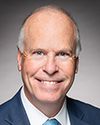Thank you for the opportunity to appear before the Standing Committee on Fisheries and Oceans.
Ocean Choice International shares the standing committee's keen interest in science at the DFO. Ocean Choice is a family-owned and operated Newfoundland and Labrador seafood company started over 20 years ago by brothers Martin and Blaine Sullivan from the southern shore, an area of the province with deep roots in the fishery.
Today, Ocean Choice is a global seafood company with extensive harvesting and processing assets throughout Newfoundland and Labrador and Atlantic Canada. Our success relies both on the inshore fishery, buying and processing raw material from approximately 1,900 independent harvesters, and on the offshore fishery through company-held quotas. Through this, we employ over 1,700 people from over 300 communities.
We are focused on employing best practices to reduce our environmental impact. We use modern processing and harvesting technology and innovative fishing gear to improve our sustainability and reduce our carbon footprint. For example, in 2020, we launched the only “green class” designated vessel in the Canadian groundfish fleet.
We are responsible for delivering wild, low-carbon, sustainable protein to the world, and it's certainly our responsibility to make sure it's available for current and future generations. Over 90% of our harvest is covered by the gold standard Marine Stewardship Council's sustainability certifications for certified fisheries and through fishery improvement projects. We invest in the collection of marine data for scientific research for DFO scientists. We fund an industry research chair in fish stock assessment at the marine institute of Memorial University, which has grown into a nucleus of training for next-generation stock assessment scientists for the department. This is really a great example of how collaborative research should be conducted.
This leads me to the focus of today: the state of fisheries science at the DFO. There is little doubt that the Government of Canada has significantly elevated investments in DFO science. However, we are concerned that these investments have primarily been to support ocean science—such as funding to support marine conservation targets, marine mammal research, etc.—as opposed to its capacity and expertise for commercial stock assessments.
While investment in ocean science is critical to monitor the health of our oceans, it is high-quality stock assessment science that ensures the sustainable and optimal utilization of Canada's fish stocks.
In our view, it is deeply disappointing that stock assessment science has not seen a comparable infusion of funding, even though demands for government-required rebuilding plans, as well as sustainability certification supports, have grown exponentially over this same time period.
Coupled with capacity challenges in science staff, alarming gaps are emerging in the DFO's multispecies fisheries vessel survey program, which provides the basis for stock assessment science. For example, in 2021, the entire multispecies spring and fall surveys were missed for NAFO divisions 3LMNO off the coast of Newfoundland and Labrador. This, coming off the back of a fully missed survey year in 2020 due to COVID-19, has resulted in two full years of missed data for a multitude of indices.
The 2022 spring survey for this area appears to also have been largely missed, resulting in, potentially, an unprecedented three-year gap in coverage, which is completely unacceptable.
The implications of this situation are massive for the Canadian seafood sector as these surveys are the basis for responsible fisheries management decision-making, resulting in reputational risk, undermining market access and sustainability certifications, and increased pressures to be even more conservative with management decisions, with an accompanying opportunity cost burden for industry.
Why the survey failures? Many reasons have been provided, ranging from COVID-19 to the aging Coast Guard fleet issues and missing calibrations with the new vessels in the fleet, but the results are the same: missing data.
We well know about vessel operational challenges. However, such challenges, while real, should be overcome by good planning on the part of the Canadian Coast Guard in managing these research vessels. It is also noteworthy that, throughout the pandemic, industry-led surveys continued to operate without interruption. These are surveys where oversight is provided by DFO science, but industry platforms are utilized for a variety of reasons, including operational and cost effectiveness.
A great example of a working industry-led survey is the Northern Shrimp Research Foundation survey, which, since 2004, has operated annually, on schedule and without delays or major disruptions at a cost well below what government can achieve.
As the committee continues to hear from stakeholders and as you develop your report on the performance of DFO science, I ask you to consider the following two recommendations.
First, government must immediately address the research vessel issues and actively plan to expand the use of industry vessels as a more reliable means of gathering much-needed data that drives good scientific advice and, ultimately, science-based decisions by the minister.
Second, I strongly urge the Government of Canada to make strategic reinvestments in fundamental fisheries science and, in particular, stock assessment modelling capacity. These are the underpinnings of fisheries management in Canada and are critical for the sustainability of our marine resources and the creation of more value from the blue economy.
Thank you for considering my input, and I welcome any comments or questions.



